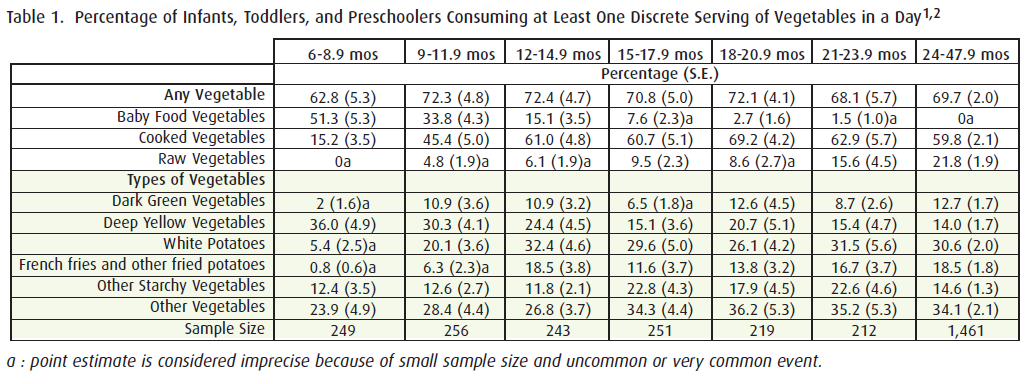Infants and Young Children Are Not Eating Enough Vegetables
Vegetables are a key component of a healthy diet. Because food acceptance patterns form early in life, it is important for parents and caregivers to introduce older infants and young children to a wide variety of vegetables, and to encourage consumption of these foods. We used data from the Feeding Infants and Toddler Study, 2008 (FITS 2008), sponsored by the Nestle Nutrition Institute, to assess patterns of vegetable consumption among infants and young children. Data on dietary intake were collected via 24-hour recalls conducted by telephone with parents or primary caregivers of infants (0-11.9 months), toddlers (12-23.9 months) and preschoolers (24-47.9 months). Below, we present three key findings from this research.
1. Substantial numbers of infants and young children consume no discrete serving of vegetables in a day.
At 6 to 8.9 months of age, 63% of infants consumed at least one discrete serving of vegetables in a day (Table 1 excluding small amounts of fruits and vegetables in mixed dishes such as pizza and spaghetti). This proportion increased to 72% among older infants but began to decline after that. Among two and three year old children, 70% consumed at least one discrete serving of vegetables in a day. Thus, for most age groups, more than one quarter of children consumed no discrete servings of vegetables in a day. In addition to lack of vegetable consumption, the types of vegetables being consumed is a concern. Consumption of nutrientdense vegetables was low. For most age groups, fewer than 15% consumed dark-green vegetables. Consumption of deep-yellow vegetables was more common, but declined substantially with age — dropping from 36% at 6 to 8.9 months of age to 14% at two to three years of age.
2. Patterns of vegetable consumption deteriorate as early as the first year of life.
Based on per capita intakes (unpublished data), the amount of any vegetable consumed dropped from 84.0±7.5 g/day among older infants (6-11.9 months) to 64.2±3.8 g/day among toddlers and 63.6±3.9 g/day among preschoolers, a downward shift that occurred as baby food vegetables fell out of the diet. A concurrent shift in the types of vegetables in the diet occurred with white potatoes replacing deep-yellow vegetables as the dominant vegetable after infancy. deep-yellow vegetables dropped from 39% of the amount of vegetables consumed among older infants to 19% and 14% among toddlers and preschoolers, respectively, while white potatoes rose from 12% of the amount of vegetables consumed among older infants to 29% among toddlers and preschoolers. By the age of two, about half the amount of white potatoes consumed were French fries (9.4±1.5 g/day), and French fries (22.9±3.1 kcal/day) contributed more than two thirds of the average total caloric intake of white potatoes (32.2±3.2 kcal/day).
3. Preschoolers are not consuming recommended amounts of vegetables.
Children two years of age and older should be Following dietary patterns recommended in the Dietary Guidelines for Americans. We assessed children’s total vegetable intake (including vegetables consumed as part of mixed dishes) using the MyPyramid Equivalents Database3 and estimated the distribution of usual vegetable intake using the personal computer version of the Software for Intake Distribution Estimation (Iowa State University). Using these methods, we found that, on average, children two to three years of age consumed 0.6 cup of vegetables per day, an amount that is 40% below the recommended amount of one cup4. Moreover, 88 percent of children in this age group consumed less than the recommended one cup of vegetables per day.
The FITS 2008 data indicate that some of the dietary patterns of concern for older children and adults begin very early in life. A major conclusion is that pediatric healthcare professionals need to encourage parents and caregivers to think about the quality of the foods they are feeding their children, as well as when to introduce specific kinds of foods. It is important to emphasize that food preferences are established early in life and may predict future eating habits. Older infants and toddlers should consume several different types of colorful, nutrient-rich vegetables each day.

References
- Siega-Riz A., D. Deming, K. Reidy, M. K. Fox, E. Condon, and R. Briefel. Food Consumption Patterns of Infants and Toddlers: Where Are We Now? J Am Diet Assoc, 2010, 110:S38-S51
- Fox, M.K., E. Condon, R. Briefel, K. Reidy, and D. Deming. Food Consumption Patterns of Young Preschoolers: Are They Starting Off on the Right Path? J Am Diet Assoc, 2010, 110:S52-D59.
- Bowman, S.A., J.E. Friday, and A.J. Moshfegh. MyPyramid Equivalents Database, 2.0 for USDA Survey Foods, 2003-2004: Documentation and User Guide. Washington, D.C.: U.S. Department of Agriculture, Agricultural Research Service, 2008.
- Fox, M.K. Are Young Preschoolers Meeting Dietary Recommendations? Presentation at the Annual Meeting of the Obesity Society, Orlando FL, Oct. 3, 2011.
